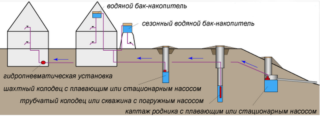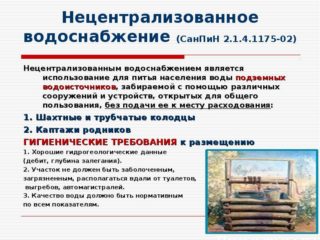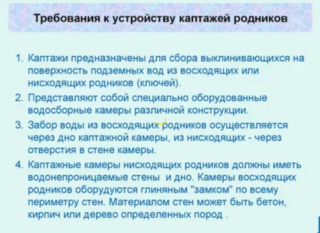SanPiN 2.1.4.1175–02 developed and compiled by doctors and candidates of sciences. Scientists from various state scientific institutions of Moscow, Saratov, Kazan, Chuvashia took part in the creation, with the participation of the Department of the State Sanitary and Epidemiological Service of the Ministry of Health of the Russian Federation. Registered on December 20, 2002, replaced the expired JV 2.1.4.554–96. Contains rules for the sanitary and hygienic use of water that does not belong to centralized sources.
General Provisions
It is customary to call non-centralized water intake for drinking and household needs, which is carried out by the population from sources located underground, and is carried out using the necessary technical devices.
The rules for the use of water bodies are mandatory for all categories of citizens. Control is entrusted to the supervisory authorities of the sanitary services.
Location requirements
The site for the arrangement of the object is chosen by the owner of the site after conducting earth surveys and on the basis of the final data obtained after the survey of the territory by specialists-hydrologists.
To obtain approval, you must have the following data:
- direction of the flow of groundwater on the terrain diagram;
- the thickness of the aquifers and the depth of their occurrence;
- the likelihood of mutual use of existing water intakes and the use of surface waters of natural origin.
The survey results should show information about the ecological and sanitary state of the water intake facility location with marks of potentially dangerous water use objects for contamination.
The location of the water intake should be located away from landfills, more than 50 meters from potentially dangerous pollution sites, more than 30 meters from highways.
Device and hardware requirements
The most commonly used structures for water intake in settlements:
- mine wells;
- tubular wells;
- capturing springs and springs.
The number of people using the source of water supply is different in each specific case, depending on the debit of the source and the established norms of water consumption.
Construction of mine wells
Wells are constructed to use water in the first free-flow aquifer with circular or square sides. Device:
- head;
- trunk;
- water intake part.
The head has the function of preventing clogging, monitoring and serves as an auxiliary lift. According to the regulations, the height of the well must be seventy centimeters above ground level. When installing the head, it is necessary to mount a cover or a cap made of reinforced concrete, which must be closed.A hinged shelter is being installed on top of the head.
Around the head, a clay castle with dimensions of 2 mx 1 m is prescribed and a concrete, stone, brick or asphalt blind area is installed within a radius of more than two meters with a slope of 10 cm in the direction from the well. A fence is placed around, and a bench for inventory near the well.
The barrel is used to lift water in buckets, the walls must have good resistance to external loads. The reinforcement is done with concrete rings laid on cement.
Rot-resistant varieties are used in wooden trunks:
- larch;
- alder;
- elm;
- oak.
The tree should be dried naturally within six months and well cleaned.
With the help of water intake, groundwater is taken and accumulated. The structure is buried in the aquifer. For the possibility of repair, brackets are mounted in the walls, and to resist contamination, the bottom is covered with filtration gravel.
The device of tubular wells
- casing;
- pump equipment;
- filter.
The head of such a well must be arranged 80-100 cm above the ground, made airtight, with a drain and a casing, and equipped with blind areas made of stone materials by analogy with mine wells.
When constructing a tubular well, chemicals and components are used that are approved by the Ministry of Health of the Russian Federation for use in drinking and household mode.
Springs capturing device
The chamber in the capturing must contain a closed neck with the possibility of penetration, have pipes for emptying and ventilation. The place next to the capturing must be fenced off.
The water intake pipe is equipped with a crane and a hook; it should rise above ground level by one and a half meters from the capturing. Nearby is an inventory bench. At the level with the ground, a container is mounted for overflowing excess water into the drain. The neck of the capturing chamber is insulated and brought out above the ground at a distance exceeding 80 cm.
The walls of the capturing must be equipped with doors and hatches necessary for inspection and repair work.
According to the properties of physical and chemical indicators, water must comply with the table given in SanPiN 2.1.4.544-96 p.4.1. Exceptions in the form of a change in certain norms or the inclusion of new ones are possible by decision of the Chief Sanitary Doctor based on the conditions of a particular region, sanitary conditions and environmental conditions.
Maintenance and operation requirements
Proper maintenance and use of the source is paramount in protecting drinking water from microbial and chemical contamination.
Car washing, keeping livestock, using water with the use of chemicals on the farm are allowed within a radius exceeding 20 meters.
The intake of water from the capturing for private use is allowed using pumping equipment, or a bucket attached to the capturing. The use of buckets for personal use is prohibited.
Insulation of capturing should be carried out with environmentally friendly materials:
- hay;
- straw;
- sawdust;
- wood shavings.
It is important to exclude the ingress of ecological heaters into the water intake systems. The use of synthetic insulation and chemicals not approved by the Ministry of Health of the Russian Federation is prohibited.
The drainage and wells are cleaned once a year at the request of the SES authorities at the expense of the state. After cleaning, the system is flushed and treated with a chlorine-containing substance.
At the end of the service life of the structure due to wear, shallowing, water damage, the owner of the water intake must eliminate it. After liquidation and backfilling of the well, it is necessary to erect a hill with a height of 20-30 cm.













